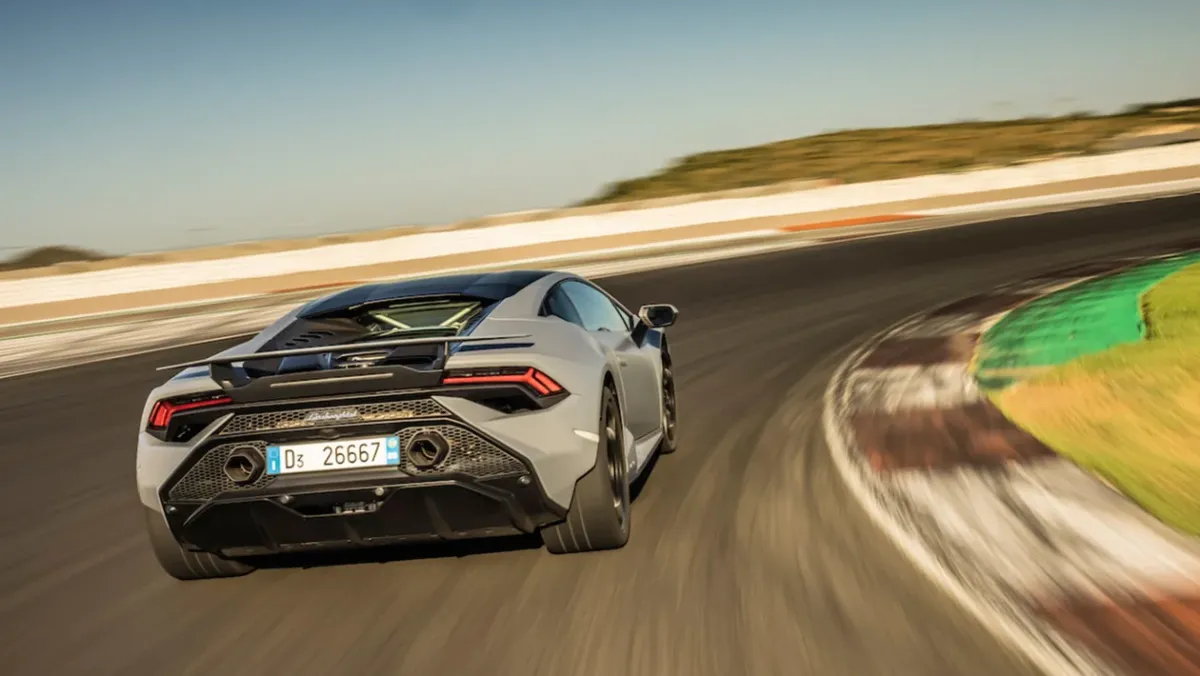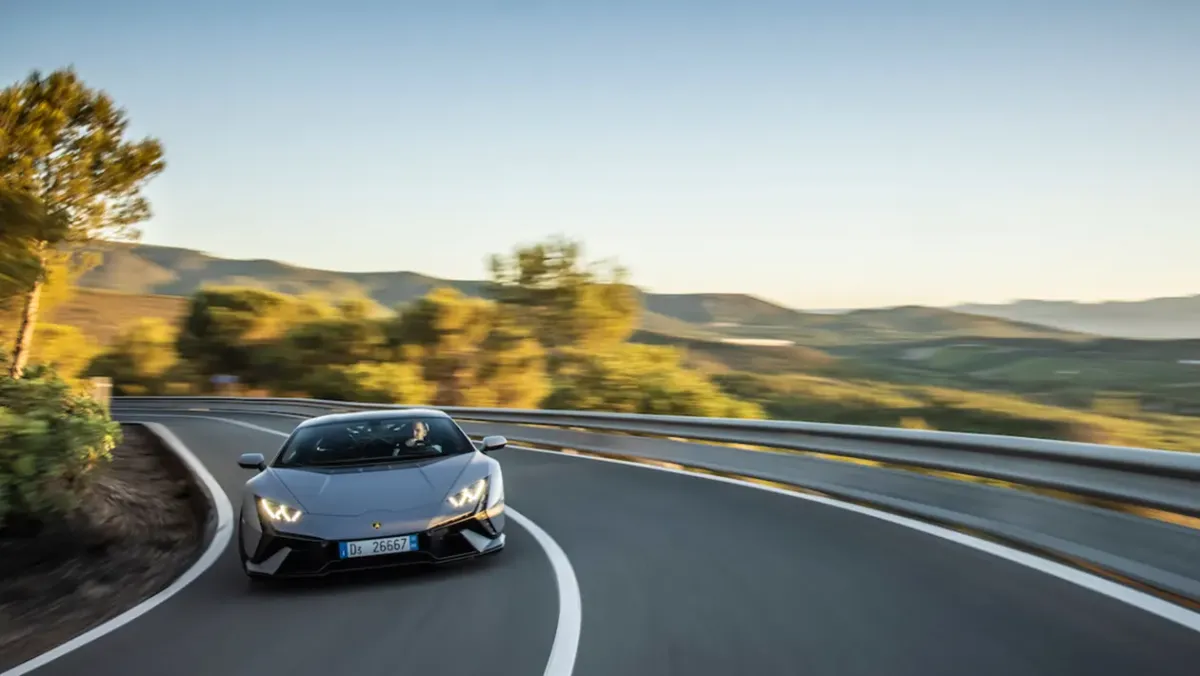A potent mix of attributes from the EVO RWD and STO, the Huracán Tecnica proves that old-fashioned recipes can still offer a knock-out blow
| Magnificent engine mated to a sublime chassis | |
| Overly sharp brakes, lack of configurable dynamic modes |
While Ferrari and McLaren embrace downsized V6 hybrid powertrains for their entry-level supercars, Lamborghini continues to blaze its own uniquely hedonistic trail as it unleashes the last series production Huracán, the $242,000 Tecnica.
Aside from a promised ‘surprise’ send-off – our money’s on the Safari-style Sterrato making limited production – the Tecnica is a last hurrah before Lamborghini’s best-selling model is replaced by an all-new hybridised supercar.
A mash-up of the sublime Huracán Evo RWD and hardcore STO, the Tecnica could be described as Lamborghini’s GT3 Touring. Taking the STO’s howling 631bhp 5.2-litre naturally aspirated V10 and mating it to toned-down styling, together with bespoke chassis set-up, aerodynamics and recalibrated dynamic modes, it’s a nose-to-tail project in which each key department grabbed the opportunity to perfect their specific area of the car.

The front-end is distinguished by Y-shaped slots inspired by the Terzo Millennio EV hypercar concept. They help generate drag-reducing ‘air curtains’ along the flanks – a first for the Huracán. A new front splitter balances the front-end downforce and directs cooling air to the brakes. The side windows and upper intakes have been tweaked to resemble the Essenza concept, a new vertical rear window improves visibility and the new carbon fibre deck lid allows hot air to escape and give a glimpse of the V10 engine beneath.
The rear bumper features cutaways to show more of the wide rear tyres, with big bore exhaust pipes poking from hexagonal surrounds. The lowline fixed spoiler completes a sharp and tidy functional makeover.
With 35 per cent more rear downforce, 20 per cent less drag and a better overall aero balance than the Evo RWD, the Tecnica cleaves the air more cleanly (top speed is 325kph), yet feels more stable at high speed.

Chassis-wise the Tecnica occupies the space between the STO and Evo RWD, with bespoke recalibrated settings that make full use of the Huracán’s adaptive damping (the tune of which is closer to the STO than the RWD), rear-wheel steering, torque vectoring and traction control systems.
There was a time, not so long ago (okay, quite a long time ago) when Lamborghinis were uncompromisingly physical machines. The Tecnica might be old-school compared to its contemporaries, but it’s still a cinch to jump into and drive, and makes easy work of driving drudgery. What’s more it brings some spice, every kilometer dusted with a little magic.
It’s on serious roads that the Tecnica comes into its own. You really shouldn’t be able to so readily exploit a rear-drive, mid-engined supercar with more than 630bhp, yet the Tecnica is so accurate and progressive that it’s genuinely playful.

Sport mode is perfectly suited to the mountain roads of the test route, allowing enough leeway to let the rear-end slip and slide under power, so it doesn’t take long to really get dialled-in to how the Huracán reacts. The V10 has tremendous reach combined with a generous spread of torque and instant throttle response so you can get the car balanced just-so. Modern turbocharging is a marvel, but you can’t beat natural aspiration for immediacy or exactness.
The soundtrack is really something, too. Mellow at low revs and modest throttle openings, Strada mode enables progress with little more than a murmur, but Sport and Corsa brings the full nape-prickling Nessun Dorma when you keep it pinned to the 8500rpm limiter. It really is a noise from the Gods.
The steering – that most critical point of contact – has terrific clarity with admirable consistency of weight and response. It’s not tingling with feedback, but what you do feel builds an accurate picture of how much grip you have to work with.

Gentle curves are taken with a slight squeeze of lock, while more meaningful turns are taken with a smooth, accurate roll of the wrists. Hairpins reveal a rare appetite for tight turns. One that’s heightened by the Tecnica’s rear-wheel steering, which has the virtual effect of shortening the car’s wheelbase in low-speed corners.
In short, the Tecnica is one of those cars that just makes you buzz. The engine noise and sense of occasion, straight-line pace, levels of grip and stopping power, and uncanny elasticity of its limits are amongst the best you’ll encounter. Likewise the 7-speed DCT gearbox. This is one of those rare supercars that will nurture novices just as readily as it will satisfy seasoned hands.
The same is true on track. We run laps in Corsa mode, which works just fine. There’s enough slip permitted to just over-rotate the rear tyres, but not enough to require anything more than a measured quarter turn of corrective lock. Disable the electronics and the Tecnica will drift for days.

Criticisms are few and far between. The main one centres upon the brake feel (these are the regular carbon ceramic discs and not the CCM-Rs from the STO) and abrupt response at the top of the pedal. Outright power and stamina are top notch, but there’s a fraction of dead travel that makes your initial input a bit of guesswork. It’s not a deal-breaker, but should be better.
One other observation is a significant shift in ride stiffness when switching from Strada to Sport. Sharp on some of the admittedly raggedy Spanish hill roads, we’ll have to see how it copes in the region. Unfortunately, it’s a reminder of the biggest frustration with the Huracán; not being able to mix-and-match your preferred settings from Strada, Sport and Corsa. It’s the one sign of ageing the Huracán can’t hide.
No matter, for the Tecnica is a stunning car. In fact it’s that rarest of things; a contemporary supercar that doesn’t rely solely on speed to feel special. Much like stars, some supercars shine brightest right before they die. The Huracán has never burned brighter.
Prices and rivals
The Tecnica’s $242,000 base price lands it neatly between the EVO RWD and STO, sitting around $34,000 between the two. For the money, not only does the Tecnica receive the STO’s more powerful V10 engine, but there’s also a collection of other upgrades over the EVO RWD such as carbon ceramic brakes, adaptive dampers and a higher interior equipment specification.
Rivalling the Tecnica is a whole variety of contemporary mid-engined supercars that vary from the closely related (and much cheaper) Audi R8 RWD Performance, to the stunningly good Maserati MC20, Ferrari F8 Tributo (yes, Ferrari still make those) and McLaren 720S. For the newest and shiniest toys in the box you’ll need to look in the direction of Ferrari and McLaren, who both pair new twin-turbo V6 engines with a hybrid module. The Artura sits a little lower in the food chain, if not in terms of performance, with its $206,000 base price, while the Ferrari 296 GTB is more serious, but then costs more, too, at nearly $285,000.
Specs
| Engine | 5204cc, V10 |
| Power | 631bhp @ 8000rpm |
| Torque | 417lb ft @ 6500rpm |
| Weight | 1379kg (dry) |
| 0-100kph | 3.2sec |
| Top speed | 325kph |
| Basic price | $242,000 |
This article originally appeared at evo.co.uk
Copyright © evo UK, Autovia Publishing






















